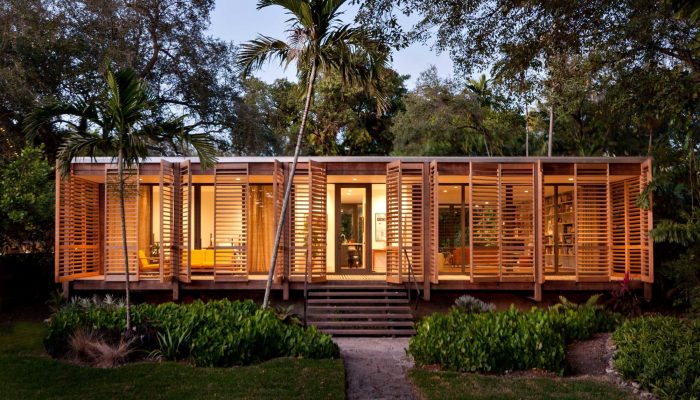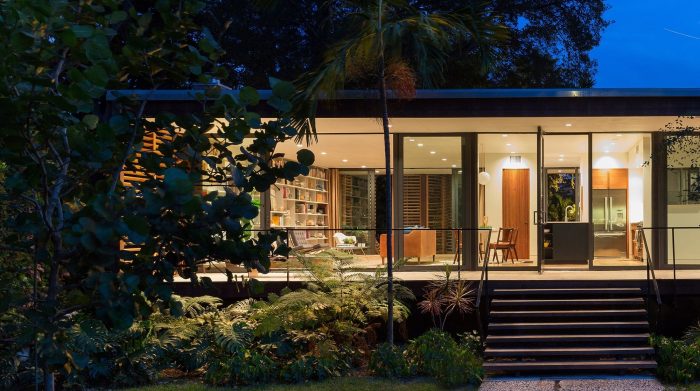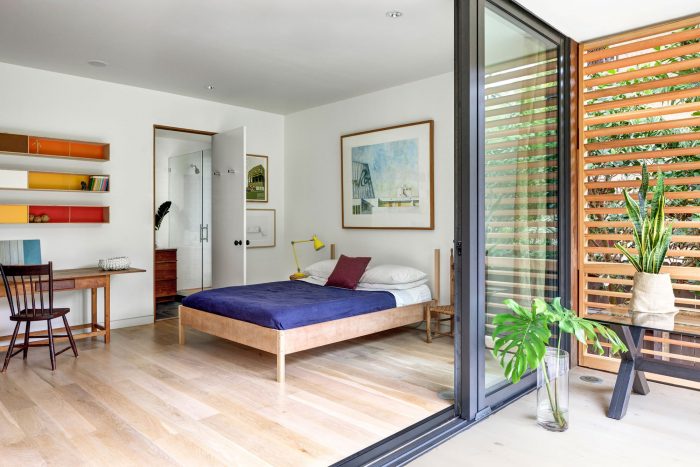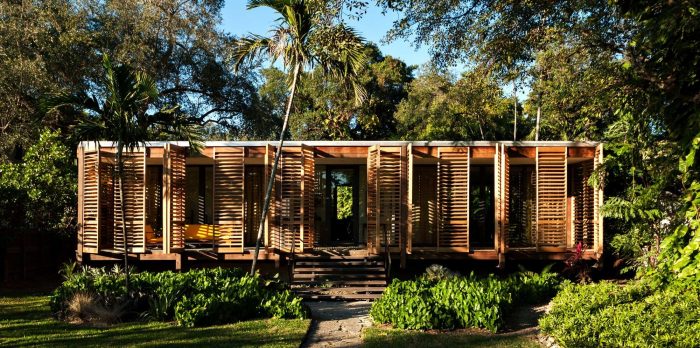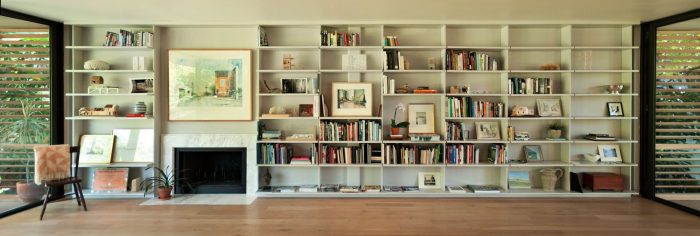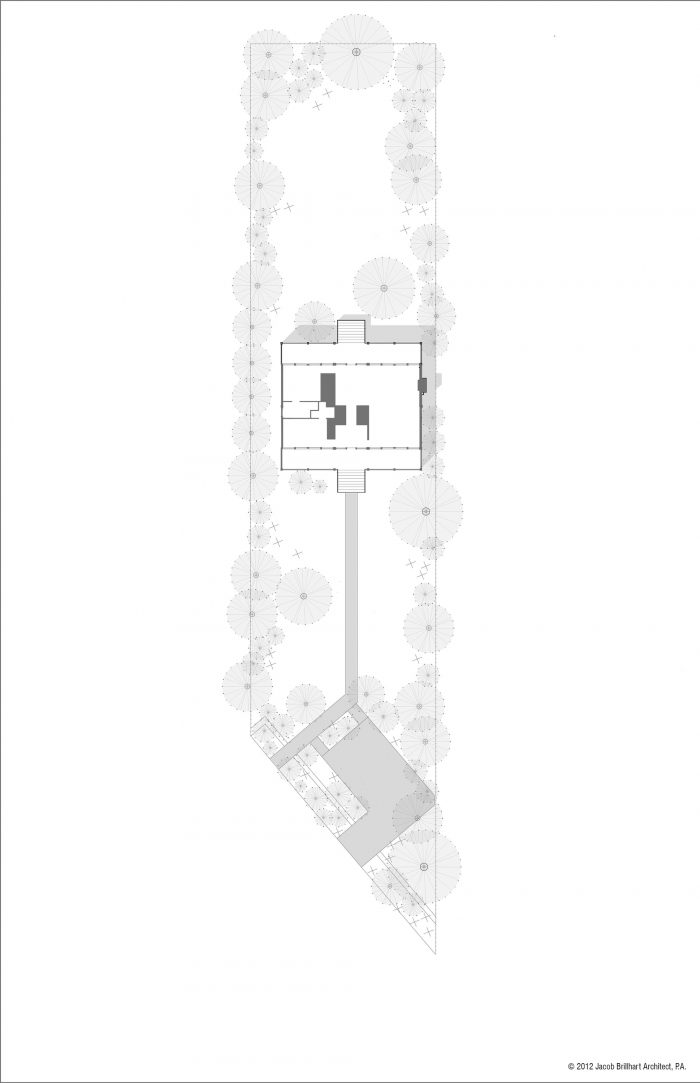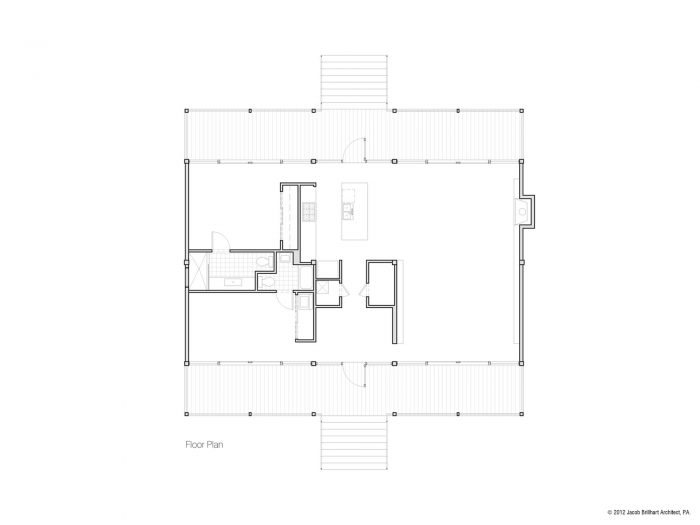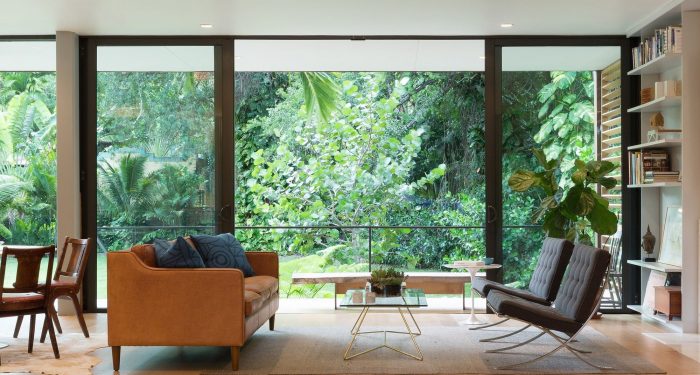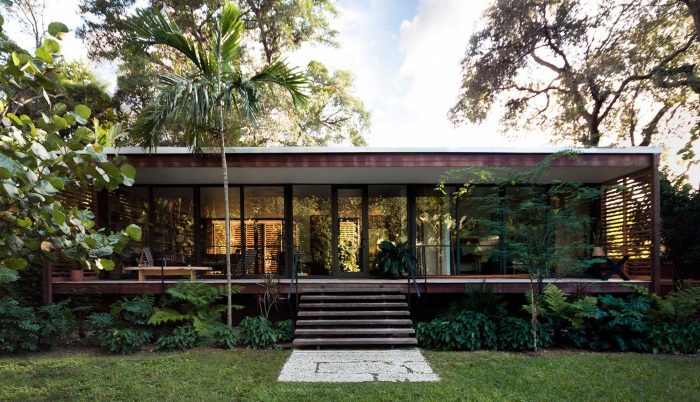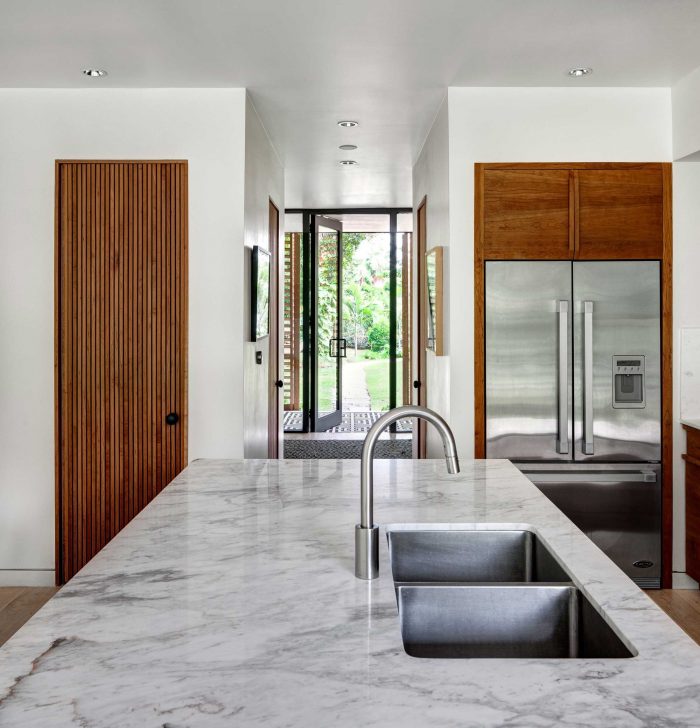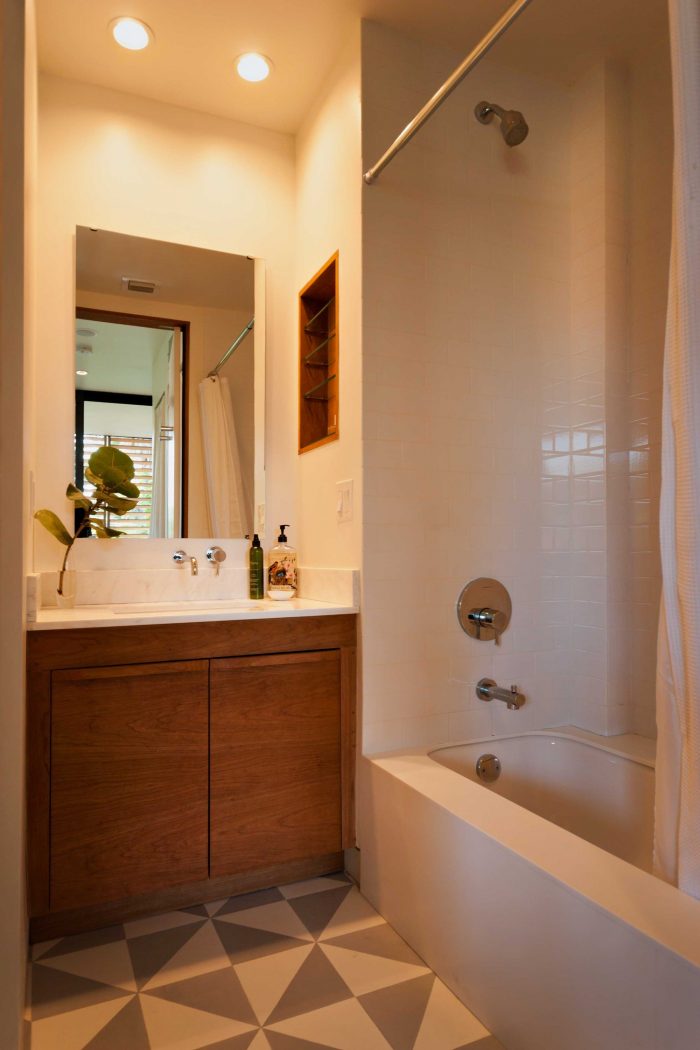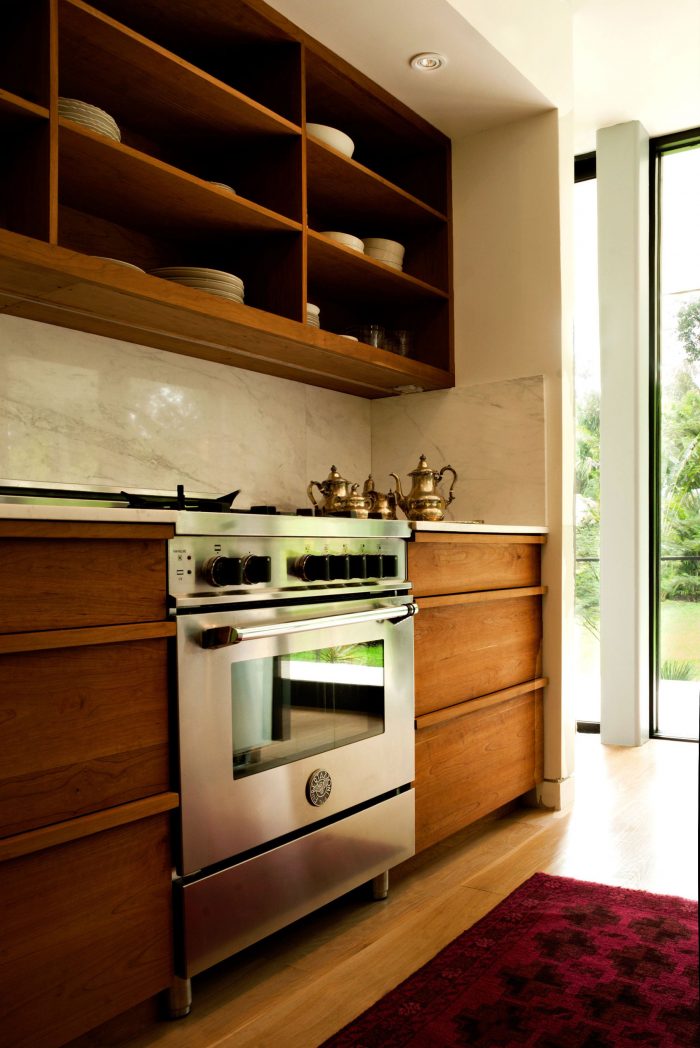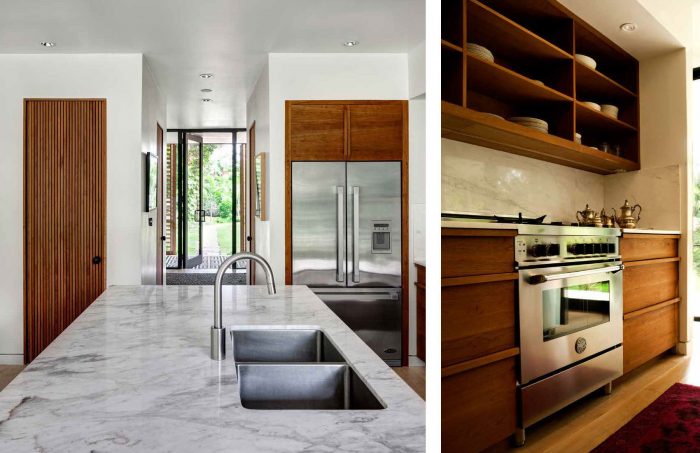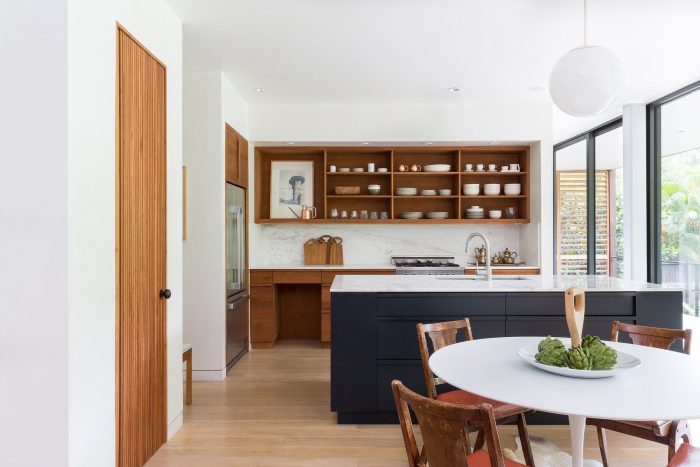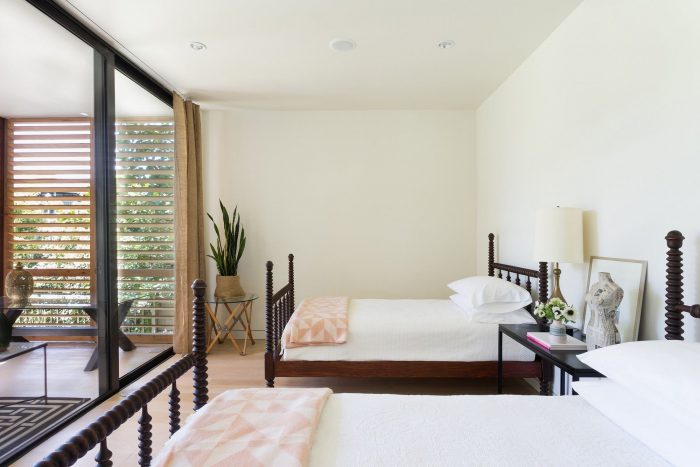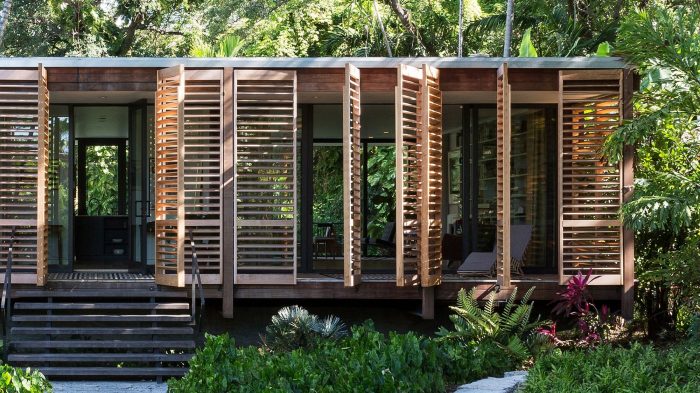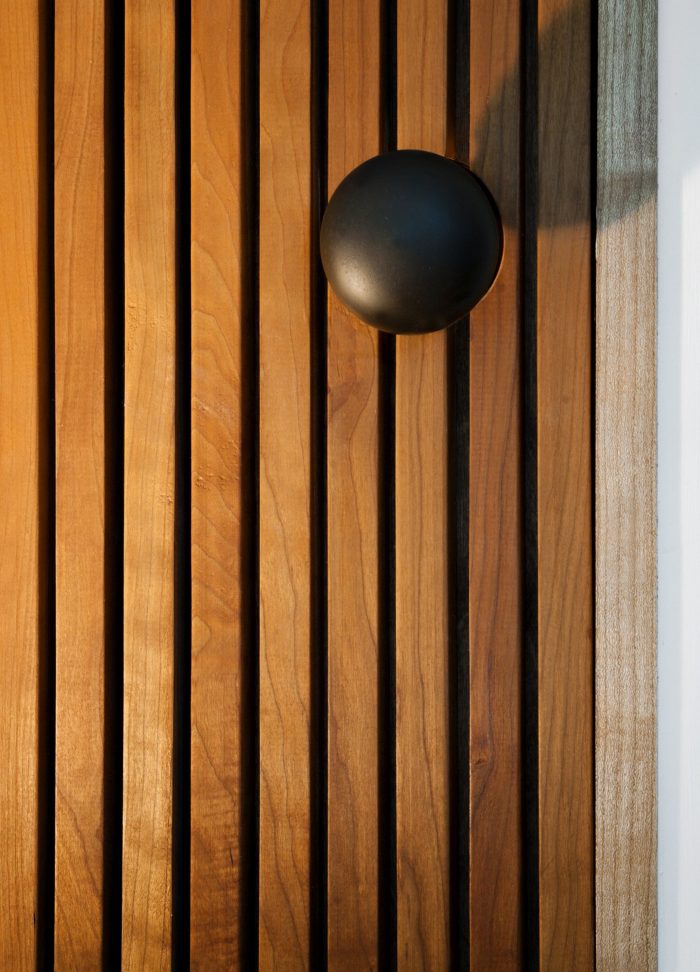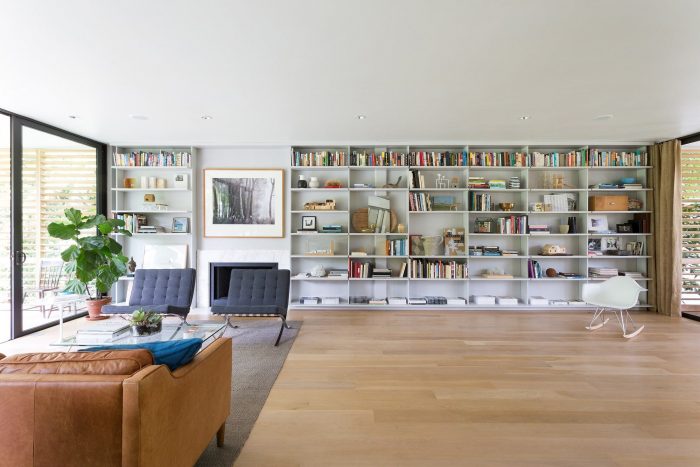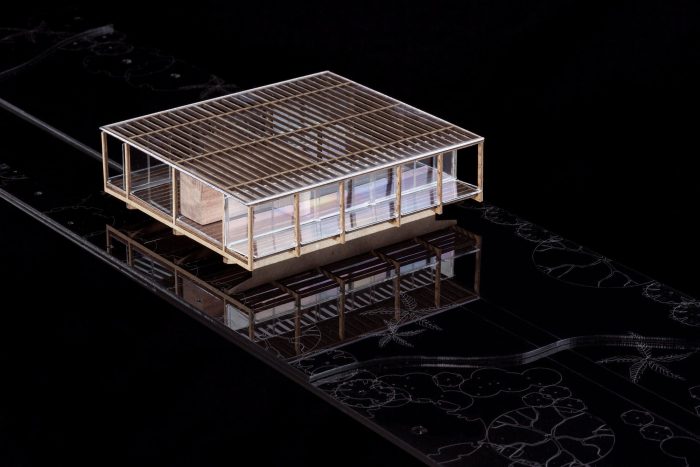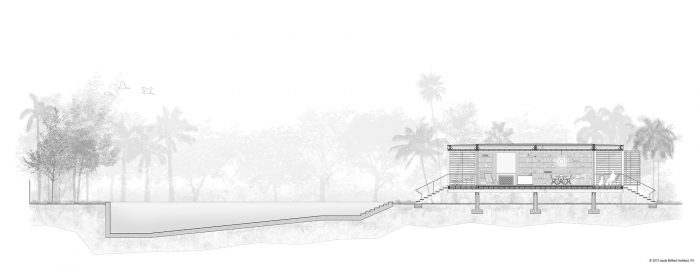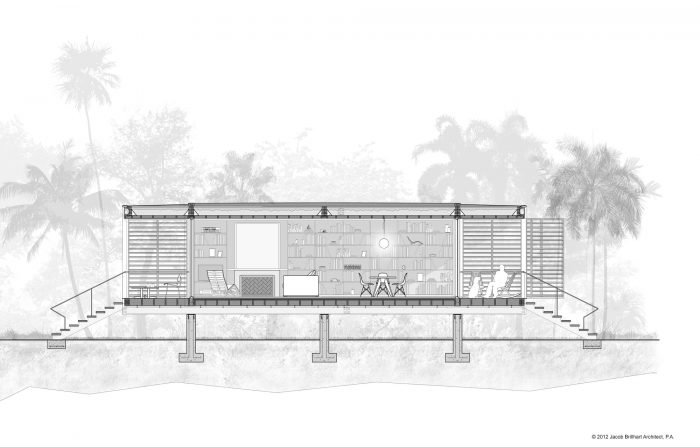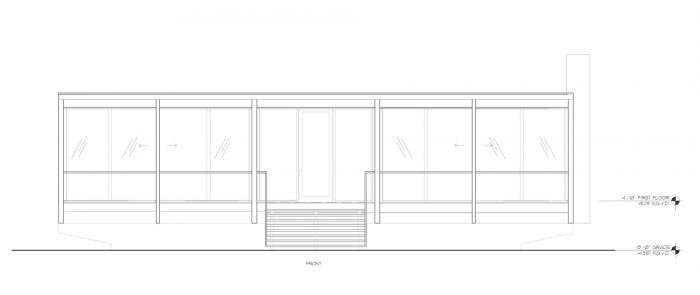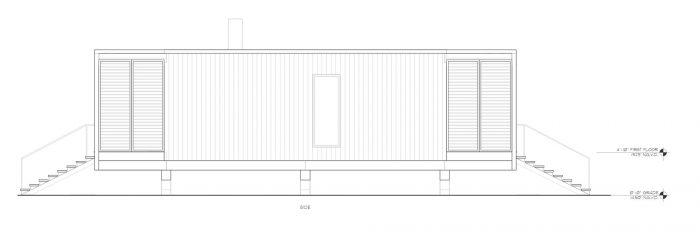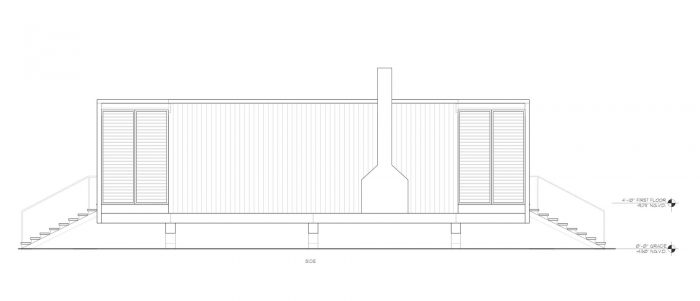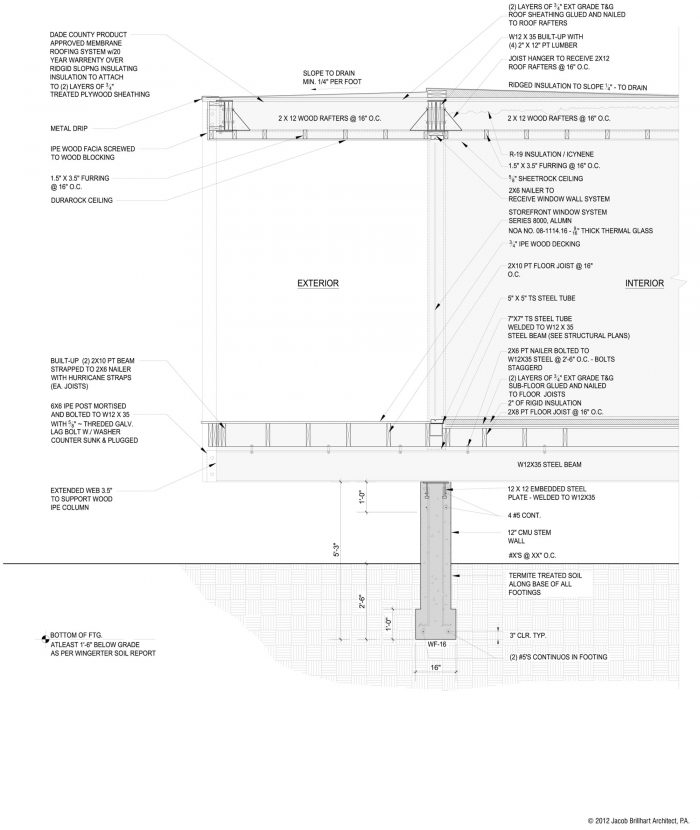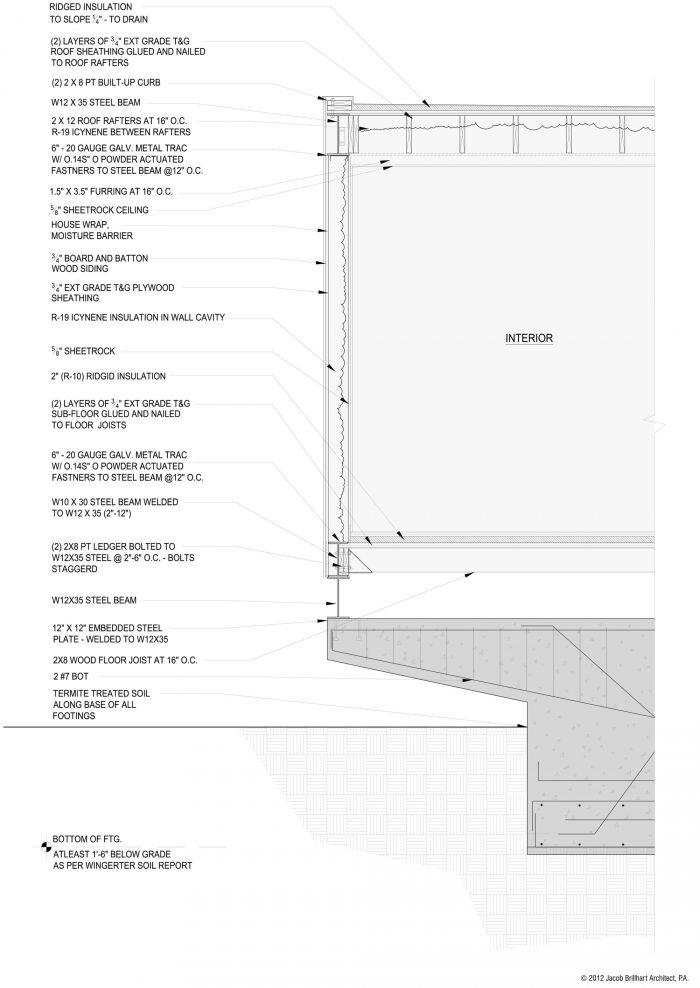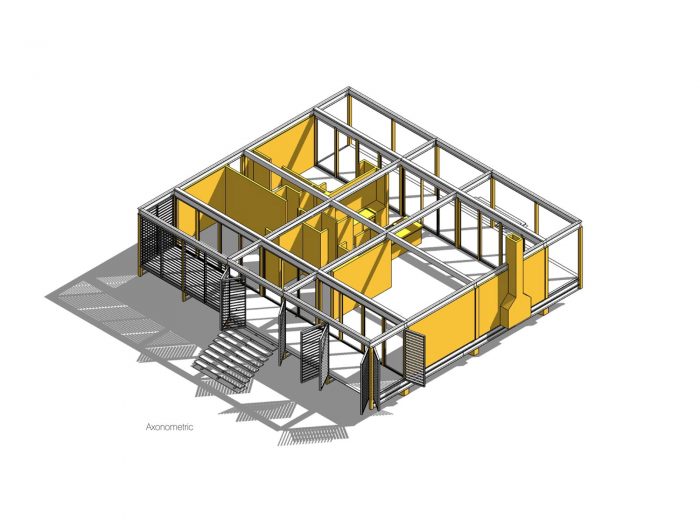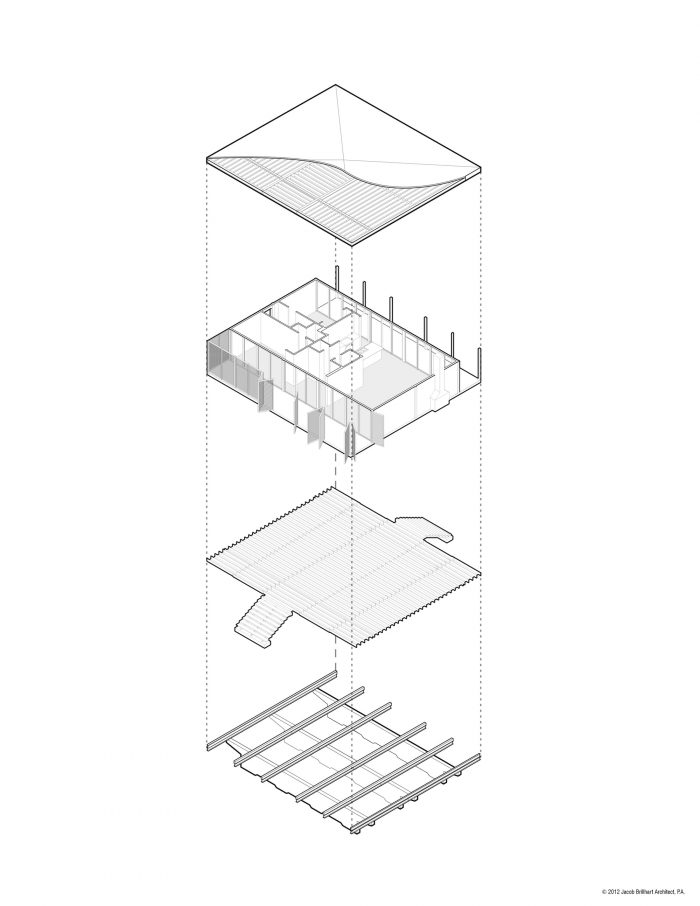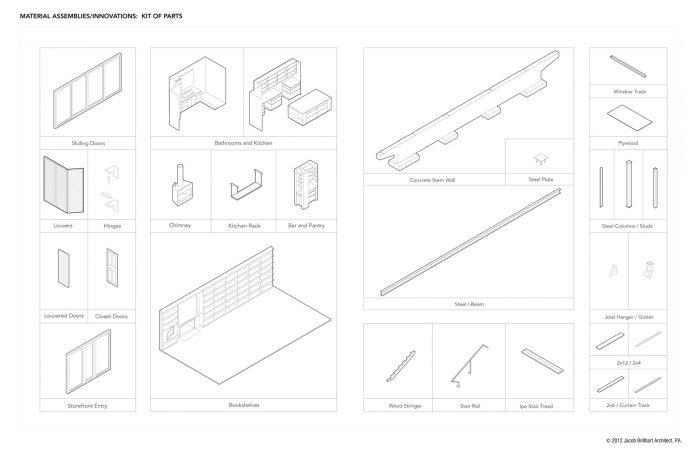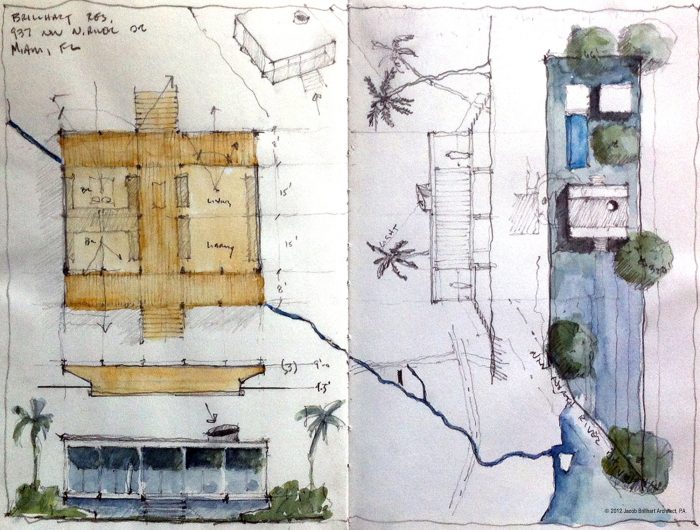生活在风景中
这个1,500平方米的房子,借鉴了美国玻璃亭的类型学,Dog Trot和佛罗里达现代主义的原则,在迈阿密市中心提供了一个热带避难所。房子离地面5英尺高,包括100英尺不间断的玻璃–50英尺横跨前后立面的长度,有四组玻璃滑动门,使房子在需要时可以完全打开。房子包括800平方英尺的室外生活空间,有前后门廊和沿正面的百叶窗门,以增加隐私和对元素的保护。这些细节,以及位于330英尺长的地块中心的房屋位置,使房屋与该地块密集而茂盛的本地景观完美融合。
LIVING IN THE LANDSCAPE
This 1,500 sf house, which draws upon the American glass pavilion typology, Dog Trot, and principles of Florida Modernism, provides a tropical refuge in Downtown Miami. Elevated 5’ off the ground, the house includes 100 feet of uninterrupted glass – 50 feet spanning the length of the front and rear facades, with four sets of sliding glass doors that allow the house to be entirely open when desired. The house includes 800 sf of outdoor living space, with front and back porches and shuttered doors along the front for added privacy and protection against the elements. These details, and the position of the house, which is at the center of a 330-foot long lot, allow the house to meld seamlessly with the site’s dense and lush native landscaping.
作为业主、建筑师和总承包商,我们自己动手建造了大部分的房子。构造学、材料学和建筑逻辑成为我们的主要兴趣。在这个以混凝土为主要建筑材料的国家,我们选择了更具可持续性的钢和玻璃上层建筑,探索了木质饰面的组合,并对建筑装配和创新进行了持续的研究。
设计理念
我们房子的设计依赖于一种返璞归真的方法–特别是研究那些关心好的形式但也是好的东西的古老建筑模型。每个设计决定都是围绕着四个中心问题来组织的,这些问题对大建筑文化提出了挑战:什么是必要的;我们怎样才能把对地球的影响降到最低;我们怎样才能尊重社区的环境;以及我们真正能建造什么?
As owners, architects and general contractors, we physically built most of the house ourselves. Tectonics, materiality and the logic of construction became of primary interest. In a part of the country where concrete is the primary construction material, we opted for a more sustainable steel and glass superstructure, explored a combination of wood finishes, and made continued investigations into construction assemblies and innovations.
DESIGN CONCEPTS
The design for our house relies on a back-to-the-basics approach – specifically studying old architectural models that care about good form but are also good for something. Each design decision was organized around four central questions that challenge the culture for building big: what is necessary; how can we minimize our impact on the earth; how do we respect the context of the neighborhood; and what can we really build?
未来建筑的旧模式
狗的小跑
一些答案来自于我们已经非常熟悉的地方–似乎被遗忘的美国乡土建筑,更具体地说,就是一个多世纪以来一直代表佛罗里达饼干建筑的主要形象的Dog Trot。这种小型的、简单的、实用的建筑既谦虚又具有丰富的文化内涵。它试图将效率、空间和能源最大化;依靠当地的建筑材料;并赞美温和的微风。
OLD MODELS FOR FUTURE BUILDINGS
Dog Trot
Some answers came from a place with which we are already intimately familiar – the seemingly forgotten American Vernacular, and more specifically, the Dog Trot, which for well over a century, has been a dominant image representing Florida Cracker architecture. The small, simple, and practical building is both modest and rich in cultural meaning. It attempts to maximize efficiency, space, and energy; relies on vernacular building materials; and celebrates the balmy breezes.
玻璃馆类型和热带现代主义
玻璃馆的类型和热带现代主义的原则也提供了方向。由于迈阿密后院的混凝土工业的蓬勃发展,迈阿密-戴德郡已经形成了对混凝土建筑的不懈坚持,以至于用其他东西来建造的想法都显得很荒谬。人们毫无根据地认为,用钢铁和玻璃建造住宅项目的成本过高;没有足够的技术工人来建造这些项目,等等。具有讽刺意味的是,我们有来自南佛罗里达的热带现代主义者的旧模型–可以追溯到20世纪50年代和60年代–由混凝土、木材、钢铁和混合系统组成的结构。这些简单、合理、高效、成本效益高的建筑颂扬了热带地区,这些设计为迈阿密的未来建筑提供了可行的创新选择。
The Glass Pavilion Typology and Tropical Modernism
The glass pavilion typology and the principles of Tropical Modernism also provided direction. Thanks to a booming concrete industry in Miami’s backyard, Miami-Dade County has developed an almost relentless adherence to building in concrete, such that the idea of building in anything else would seem absurd. There is an unfounded, albeit pervasive, belief that the costs associated with building a residential project in steel and glass would be exorbitant; that there isn’t enough skilled labor on hand to build such projects, and so on. Ironically, we have old models from South Florida’s Tropical Modernists – dating back to the 1950s and ‘60s – of structures made of concrete, wood, steel, and hybrid systems. Simple, rational, efficient, cost-effective buildings that celebrate the tropics, these designs lend feasible and innovative alternatives for Miami’s future buildings.
南佛罗里达州的战后建筑师–如阿尔弗雷德-布朗宁-帕克、鲁菲斯-尼姆斯、罗伯特-布拉德福德-布朗、马克-汉普顿、保罗-鲁道夫和拉尔夫-特维尔、威廉-摩根、唐纳德-辛格、吉恩-利迪等人–诞生了一个热带现代思想流派,通过对当地景观、气候和材料的研究,对国际风格做出了自己的区域解释。在一个乐观主义和实验的时代,这些建筑师将建筑传统与被动系统、新技术和创新的施工技术结合起来。对施工方法的强调是他们工作的核心,并成为热带地区可持续设计的典范。
作为研究的一部分,我们分析了南佛罗里达战后时期建造的四座住宅的原始建筑文件。首先绘制了设计意图图,然后我们制作了新构建的轴测图(如上图左),分解了材料的选择和系统(建筑)的组合。作为模型,这四个项目展示了令人难以置信的材料和建筑系统的范围。作为一个视觉工具箱,它们为我们在这个项目上提供了巨大的资源。
South Florida’s postwar architects – such as Alfred Browning Parker, Rufis Nims, Robert Bradford Browne, Mark Hampton, Paul Rudolf and Ralph Twitchell, William Morgan, Donald Singer, Gene Leedy, and others – gave birth to a tropical modern school of thought and developed their own regional interpretations of the International Style by turning to local landscape, climate and materials to inform their designs. In an era of optimism and experimentation, these architects married building traditions with passive systems, new technologies, and innovative construction techniques. Emphasis on construction methodology was central to their work and became a model for sustainable design in the tropics.
As part of our research, we analyzed the original construction documents from four residences built during South Florida’s Post-war period. First diagramming the design intent, we then made newly constructed axonometrics (shown above, left) that break down the material selections and systematic (architectonic) assemblies. As models, these four projects display an incredible range of materials and building systems. As a visual tool-kit, they served as a tremendous resource for us on this project.
建筑和细节
钢和玻璃的上部结构
回溯南佛罗里达州战后建筑的乐观主义和实验精神,我们寻求替代混凝土和水泥的使用,而是探索用钢和玻璃作为上层建筑。因此,我们浪费了更少的材料,简化了装配,减少了施工的成本和时间,同时允许增加交叉通风和提高景观中的生活感。
CONSTRUCTION AND DETAILS
Steel and Glass Superstructure
Harking back to the optimism and experimentation of South Florida’s postwar architecture, we sought an alternative to the use of concrete and concrete only, instead exploring steel and glass as the superstructure. As a result, we wasted fewer materials, simplified the assembly, and reduced the cost and time of construction, all the while allowing for increased cross ventilation and a heightened sense of living within the landscape.
玻璃和绝缘材料
随着今天玻璃和隔热材料热质量的进步,我们能够使用热带现代概念和当前佛罗里达州建筑规范的要求。为了达到和/或超过所要求的R值,我们在所有六面都安装了隔热材料(冰棉和硬质隔热材料);以及9/16英寸厚的隔热玻璃。在这个过程中,我们还必须设计新的组件。其一,新的法规刚刚出台,要求对抬高的地板进行保温。由于这是一个新的要求–我们不得不开发一个全新的地板细节–创造一个夹层,下面是胶合板,上面是一层硬质保温层。同时,为了达到屋顶的R值并适应轻微的坡度,我们设计了一个类似但相反的概念–在屋顶上安装锥形的硬质保温材料,下面是一层胶合板,再下面是冰晶石。(R值是建筑和施工行业中使用的热阻的衡量标准。它被表示为材料的厚度除以导热性。数值越高,建筑保温的效果越好。 屋顶隔热材料的设计导致了R值超过了要求)。
Glass and Insulation
With today’s advances in thermal qualities of glass and insulation we were able to use the Tropical modern concepts alongside current Florida Building Code requirements. To meet and/or exceed the required R-Values, we included insulation on all six sides (icynene and rigid insulation); as well as 9/16″ thick thermal glass. We also had to design new assemblies in the process. For one, the new code just came out with requirements to insulate the floor if elevated. As this is a new requirement — we had to develop an entirely new floor detail – creating a sandwich with plywood underneath and on top of a layer of rigid insulation. Meanwhile, in order to achieve the R-Value on the roof and accommodate a slight slope, we designed a similar but inverse concept – installing tapered rigid insulation on the roof, with a layer of plywood underneath followed by icynine below. (The R-value is a measure of thermal resistance used in the building and construction industry. It is expressed as the thickness of the material divided by the thermal conductivity. The higher thenumber, the better the building insulation’s effectiveness. The design for the roof insulation resulted in a R-Value that exceeded what was required.)
Architects: Brillhart Architecture
Area : 1500 ft²
Year : 2014
Photographs :Bruce Buck, Claudia Uribe, Stefani Fachini
Manufacturers : ABS Wood, Amazon, Amazon Grohe, BestBuy, Bond Supply, Bouche Appliances, Casa Cielo, Designer Tops, Faucets Direct or E Faucets, Flat River Woodworking, Howell Logging, Intercontinental Marble, Marmol, Tidewater Lumber and Moulding
City:MIAMI
Country:UNITED STATES


